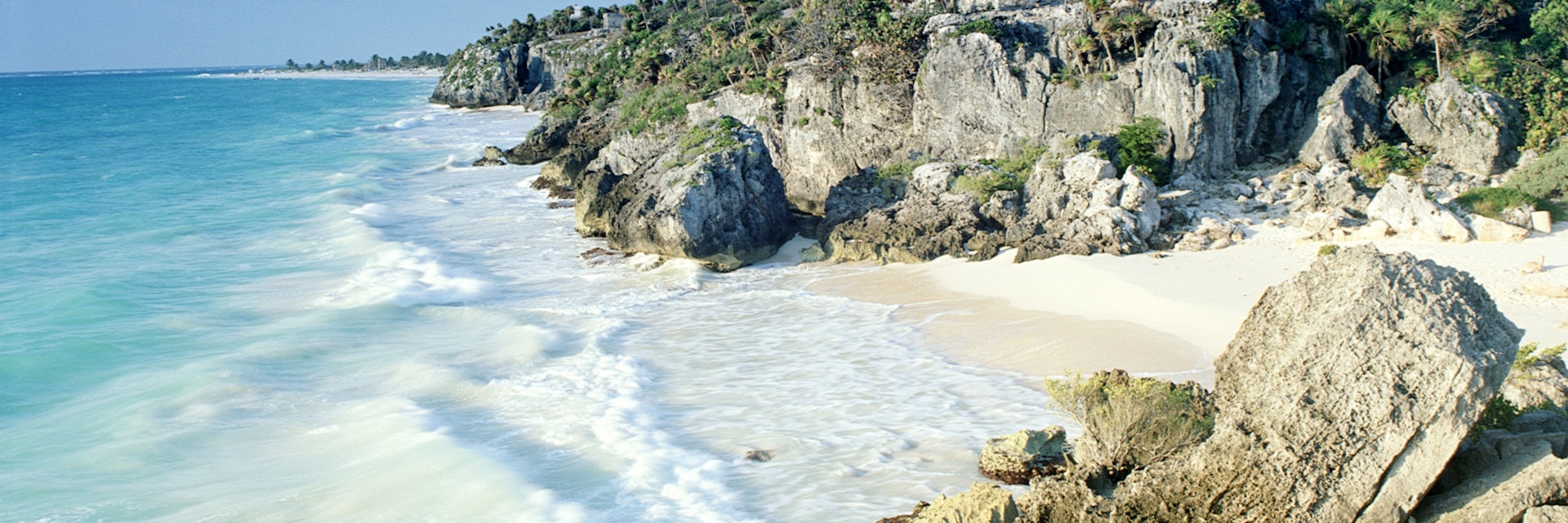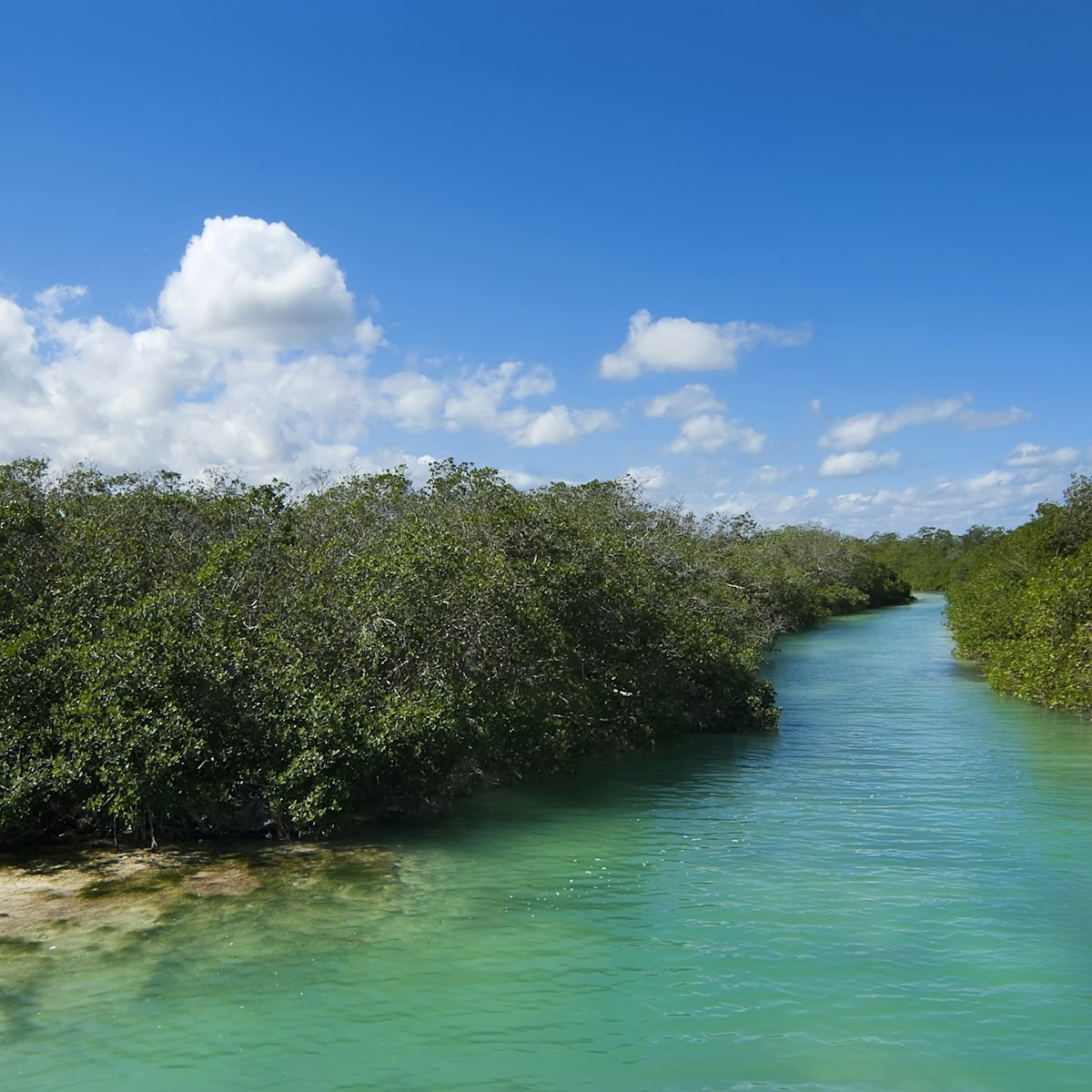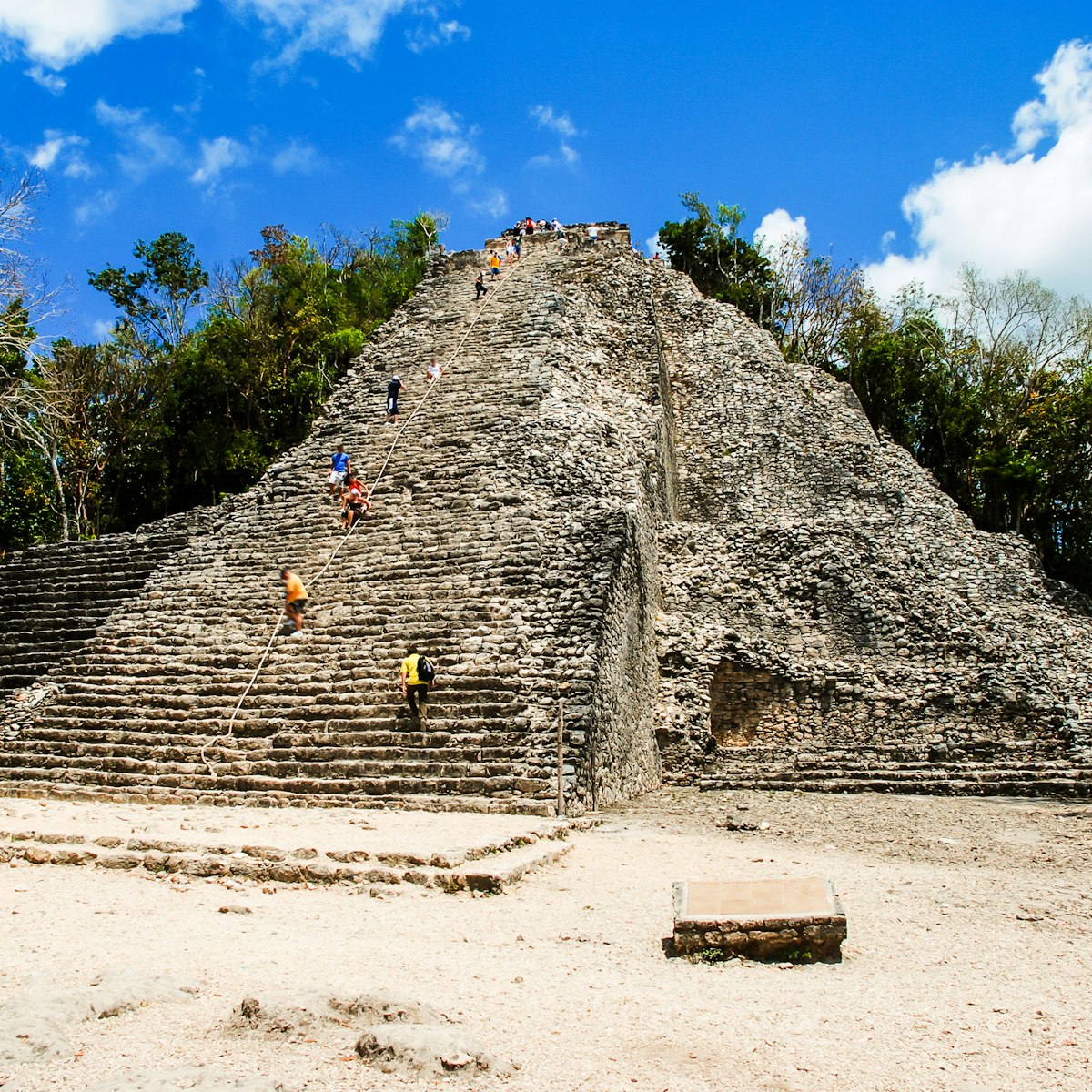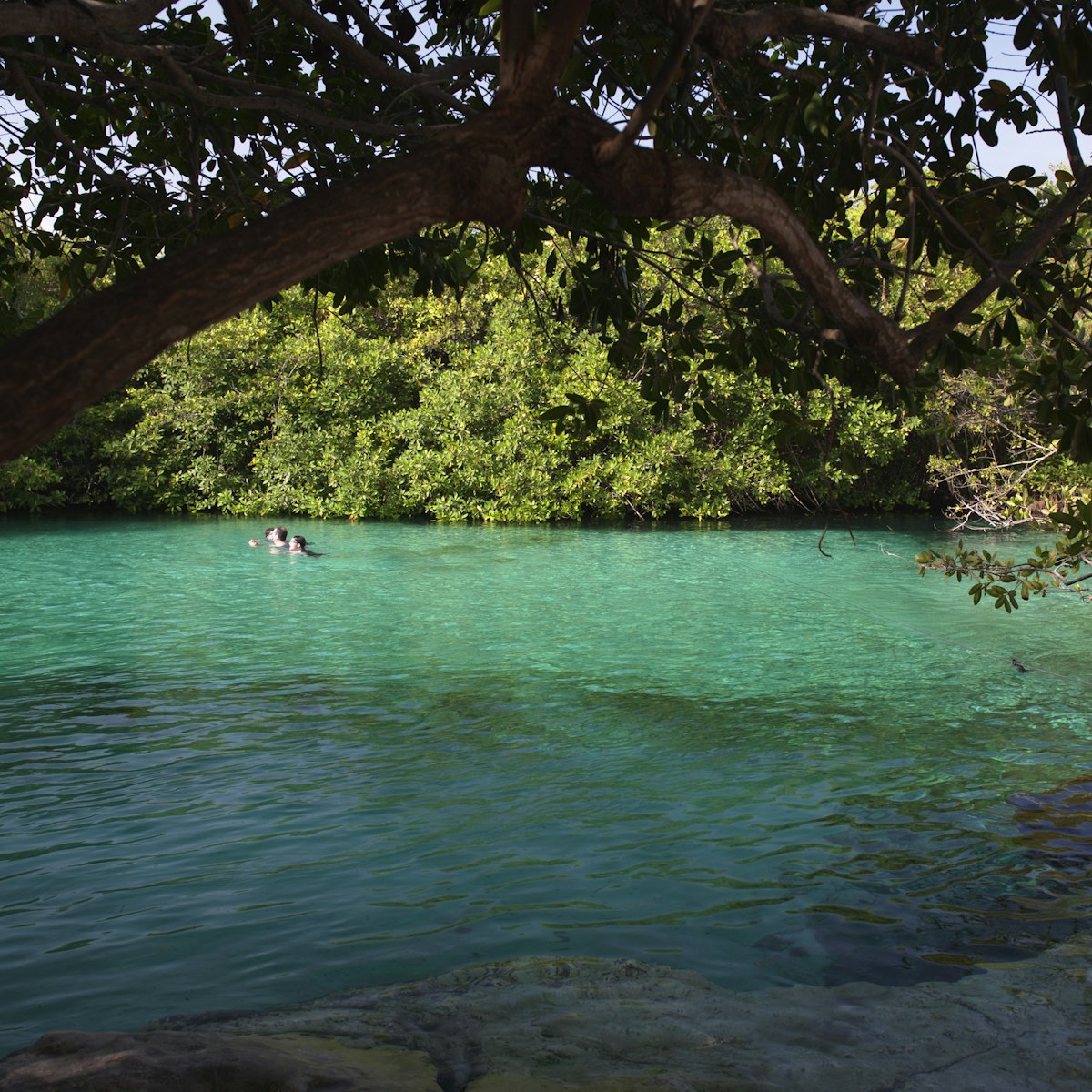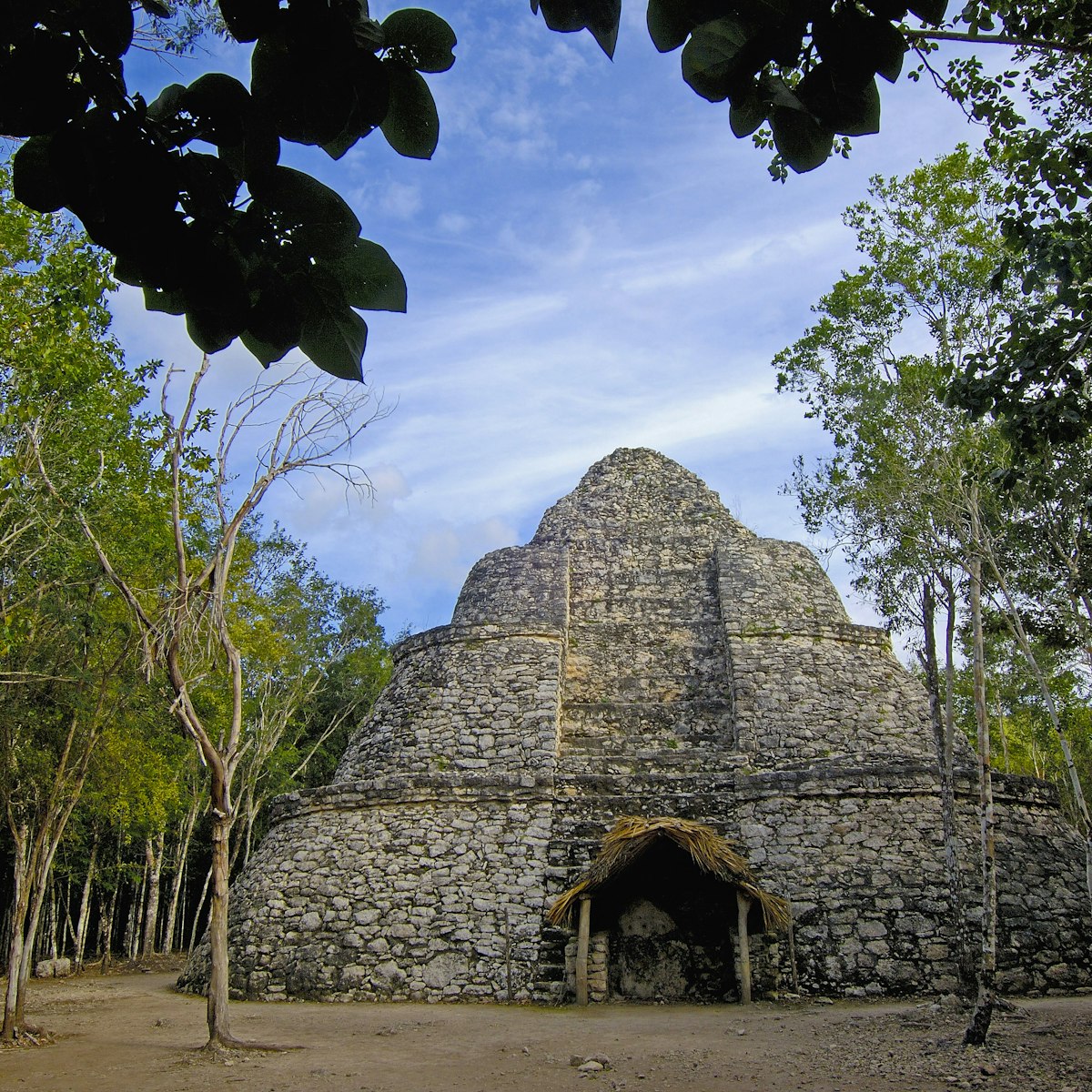Tulum is one of the most visited archaeological zones in Mexico and for good reason: it’s sublime. The ruins sit on seaside cliffs, high above turquoise waters that extend as far as your eye can see. True, the structures themselves are modest in comparison to other grand Maya cities. But Tulum captures your imagination like no other, perhaps conjuring visions of pre-Columbian tradesmen arriving in canoes laden with goods, and the Maya workers who received them, contemplating the same bracing views.
History
Inhabited as early as 564, Tulum’s heyday wasn’t until 1200–1521 when it served as an important port town, controlling maritime commerce along the Caribbean coast to Belize. When the Spanish conquistador Juan de Grijalva sailed past in 1518, he was amazed by the sight of the walled city, its buildings painted a gleaming red, blue and yellow, and a ceremonial fire burning atop its seaside watchtower.
Yet, only 75 years after the Spanish conquest, the city was abandoned, its population decimated by European-borne diseases. For hundreds of years afterward, nature reclaimed the city, and it was unknown to the outside world until the mid-1800s when explorers John Stephens and Frederick Catherwood published detailed descriptions and drawings of it. Foreign travelers didn’t begin arriving in earnest for another 100-plus years, though Maya pilgrims and indigenous refugees taking shelter during the Caste War used the site intermittently.
Meaning of Tulum
Tulum means “wall” in Yucatec Maya, a reference to the city’s fortifications; 19th-century explorers used the name and it stuck. Originally, the city was called Zamá, or “dawn,” because it faced east.
How to navigate Tulum
Tulum is a compact archaeological zone, contained entirely within its enormous stone walls. The entrance is on the north side. Starting with the oceanfront structures and walking clockwise through the site, you’ll see it all in a couple hours, longer if you stay for a swim. The exit is through the south wall.
Principal structures
The three ramparts (walls) surrounding Tulum are 3m to 5m high, and measure between 170m to 380m long. They served to enclose and fortify the city, protecting the city’s civic-ceremonial buildings, palaces and the ruling classes who lived there. The vast majority of the residents, Tulum’s working class, lived outside the walls.
The most photographed structure is Templo del Dios de Viento, a small temple perched on a rocky outcrop, the Caribbean waters perfectly framing it. The structure’s circular base is associated with the god of wind, for which it is named. It’s believed that the roof had a special opening that would whistle when hurricanes approached to warn Tulum’s residents.
Templo del Dios Descendente is named after the relief figure of a descending god above the building's door. The image, perhaps the most iconic of Tulum, is associated with the highly revered god of bees. At the spring equinox, a ray of sunlight shines through the temple, aligning perfectly under the image.
Sitting on a dramatic bluff, El Castillo is the tallest (7.5m) and most imposing structure in Tulum. Built in several phases, it served as a lighthouse, with a shrine at the top doubling as a beacon to lead canoes to the beach landing. Look for the plumed serpents hugging the pyramid’s corners, a reflection of regional influence of the Toltecs.
Templo de las Pinturas was an observatory used to track the movements of the sun. It features some of Tulum's most elaborate décor – now quite weathered – including carved figures of the descending god, stucco masks and colorful murals on interior walls depicting various Maya gods.
The beach
Tulum is one of the few Maya ruins with a beach – two, in fact – the ancient structures sitting like sentinels above them. Add to that the seaside cliffs and the impossibly blue waters, and bringing your swimsuit is a no-brainer. The main beach is beneath El Castillo, at the bottom of a steep wood staircase. By late morning, it’s often crowded with visitors playing in the waves and posing on the sand. A second beach, just as lovely, is below the Templo del Dios de Viento. Reachable by a sandy trail, it’s typically cordoned off but is a good spot for selfies.
Tours
Tours (from M$700) are offered onsite by certified guides who hustle for customers at the visitors complex and near the ticket booth. Tours last about two hours and can offer invaluable insights into this ancient city.
Tickets
Tickets cost M$80 and can only be purchased onsite. The ruins are open from 9am to 5pm, but the last entry is at 3:30pm.
Things you should know
- Arrive early. It’ll give you a shot at enjoying the ruins before the mass tour groups descend, typically by 11am.
- Visitors are not allowed to climb on or enter most the structures in order to protect them from erosion. Respect the barriers and “do not enter” signs.
- Bring a hat and plenty of water. May to September are the hottest months here, but it’s sunny and humid year-round and the ruins have very little shade.
Eating and drinking
Centro Artesanal Tulum, a handicrafts mini-mall in the visitors complex, has a few sit-down restaurants and fast-food joints. Prices are inflated, but they’ll do in a pinch. You can grab snacks and drinks here too. (There’s even a Starbucks.)
Getting there
Tulum’s visitor complex is just off Hwy 307, on the outskirts of town. From there, it’s another 1km to the ticket booth and archaeological site – a trolley (M$55) shuttles people or you can just hoof it. From town, taxis charge a fixed rate to the complex (M$100). Northbound colectivos (shuttle vans) will drop you on the highway (M$20) a couple blocks away. If you’re driving, there’s plenty of parking in the main lot (M$180).
Alternatively, Tulum’s beach road becomes a pedestrian-only road to the ruins, about a 400m walk to the ticket booth. It’s a popular access point for those staying on the oceanfront (and for those who want to hit the beach after a visit to the ruins).
